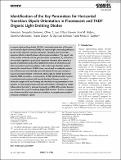Files in this item
Identification of the key parameters for horizontal transition dipole orientation in fluorescent and TADF organic light-emitting diodes
Item metadata
| dc.contributor.author | Tenopala-Carmona, Francisco | |
| dc.contributor.author | Lee, Oliver S. | |
| dc.contributor.author | Crovini, Ettore | |
| dc.contributor.author | Neferu, Ana M. | |
| dc.contributor.author | Murawski, Caroline | |
| dc.contributor.author | Olivier, Yoann | |
| dc.contributor.author | Zysman-Colman, Eli | |
| dc.contributor.author | Gather, Malte C. | |
| dc.date.accessioned | 2021-08-02T14:30:10Z | |
| dc.date.available | 2021-08-02T14:30:10Z | |
| dc.date.issued | 2021-08-02 | |
| dc.identifier | 273926880 | |
| dc.identifier | 4119ddfb-cdde-4a31-b8f8-84c12ab078d4 | |
| dc.identifier | 85111651821 | |
| dc.identifier | 000680014200001 | |
| dc.identifier.citation | Tenopala-Carmona , F , Lee , O S , Crovini , E , Neferu , A M , Murawski , C , Olivier , Y , Zysman-Colman , E & Gather , M C 2021 , ' Identification of the key parameters for horizontal transition dipole orientation in fluorescent and TADF organic light-emitting diodes ' , Advanced Materials , vol. Early View , 2100677 . https://doi.org/10.1002/adma.202100677 | en |
| dc.identifier.issn | 0935-9648 | |
| dc.identifier.uri | https://hdl.handle.net/10023/23697 | |
| dc.description | This research was financially supported by the Volkswagen Foundation (No. 93404), the European Commission under EU Horizon 2020 Grant Agreement No. 812872 (TADFlife), the European Research Council under the European Union's Horizon 2020 Framework Programme (FP/2014-2020)/ERC grant agreement no. 640012 (ABLASE), and The Leverhulme Trust (RPG-2016047). M.C.G. acknowledges support from the Alexander von Humboldt Stiftung through the Humboldt-Professorship. All computations were performed using resources kindly provided by the University of Mons (UMONS), supported by the Belgian National Fund for Scientific Research (FRS-FNRS). Computational resources were provided by the Consortium des Équipements de Calcul Intensif (CÉCI) funded by F.R.S.-FNRS under Grant 2.5020.11. Y.O. acknowledges funding from the FRS-FNRS under the grant F.4534.21 (MIS-IMAGINE). | en |
| dc.description.abstract | In organic light-emitting diodes (OLEDs), horizontal orientation of the emissive transition dipole moment (TDM) can improve light outcoupling efficiency by up to 50% relative to random orientation. Therefore, there have been extensive efforts to identify drivers of horizontal orientation. The aspect ratio of the emitter molecule and the glass-transition temperature (Tg) of the films are currently regarded as particularly important. However, there remains a paucity of systematic studies that establish the extent to which these and other parameters control orientation in the wide range of emitter systems relevant for state-of-the-art OLEDs. Here, recent work on molecular orientation of fluorescent and thermally activated delayed fluorescent emitters in vacuum-processed OLEDs is reviewed. Additionally, to identify parameters linked to TDM orientation, a meta-analysis of 203 published emitter systems is conducted and combined with density-functional theory calculations. Molecular weight (MW) and linearity are identified as key parameters in neat systems. In host–guest systems with low-MW emitters, orientation is mostly influenced by the host Tg, whereas the length and MW of the emitter become more relevant for systems involving higher-MW emitters. To close, a perspective of where the field must advance to establish a comprehensive model of molecular orientation is given. | |
| dc.format.extent | 28 | |
| dc.format.extent | 6201349 | |
| dc.language.iso | eng | |
| dc.relation.ispartof | Advanced Materials | en |
| dc.subject | Meta-analysis | en |
| dc.subject | Molecular oreintation | en |
| dc.subject | Multiple linear regression | en |
| dc.subject | ORganic light-emitting diodes | en |
| dc.subject | Thermally activated delayed fluorescence | en |
| dc.subject | QC Physics | en |
| dc.subject | QD Chemistry | en |
| dc.subject | DAS | en |
| dc.subject.lcc | QC | en |
| dc.subject.lcc | QD | en |
| dc.title | Identification of the key parameters for horizontal transition dipole orientation in fluorescent and TADF organic light-emitting diodes | en |
| dc.type | Journal item | en |
| dc.contributor.sponsor | European Commission | en |
| dc.contributor.sponsor | European Research Council | en |
| dc.contributor.institution | University of St Andrews. School of Chemistry | en |
| dc.contributor.institution | University of St Andrews. EaSTCHEM | en |
| dc.contributor.institution | University of St Andrews. Sir James Mackenzie Institute for Early Diagnosis | en |
| dc.contributor.institution | University of St Andrews. Centre for Biophotonics | en |
| dc.contributor.institution | University of St Andrews. Biomedical Sciences Research Complex | en |
| dc.contributor.institution | University of St Andrews. School of Physics and Astronomy | en |
| dc.identifier.doi | 10.1002/adma.202100677 | |
| dc.description.status | Peer reviewed | en |
| dc.identifier.grantnumber | 812872 | en |
| dc.identifier.grantnumber | 640012 | en |
This item appears in the following Collection(s)
Items in the St Andrews Research Repository are protected by copyright, with all rights reserved, unless otherwise indicated.

